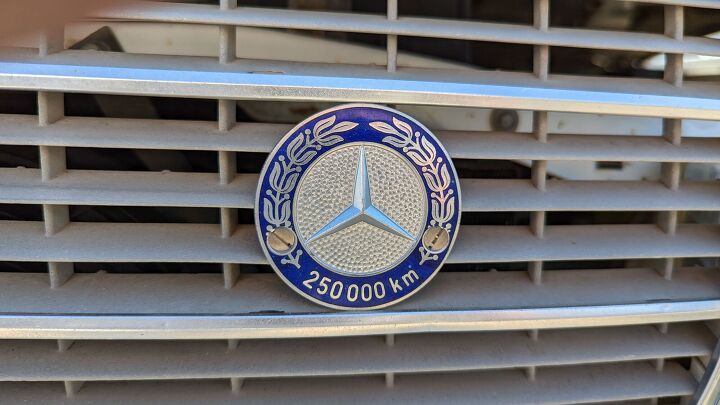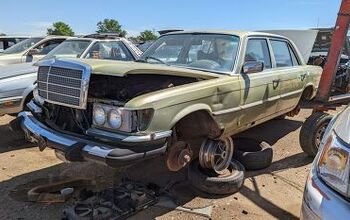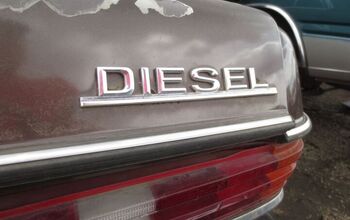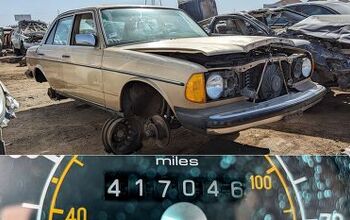Junkyard Find: 1978 Mercedes-Benz 240 D

The engine of the current Mitsubishi Mirage, much derided for its alleged slowness, must pull a bit more than 27 pounds of car for each of its 78 horsepower. That's underpowered, yes? Not compared to the Mercedes-Benz W123 equipped with a naturally-aspirated four-cylinder diesel engine! That's the car we're going to admire for this week's Junkyard Find.
I found this '78 in the same Wyoming self-service boneyard that gave us the 1938 Oldsmobile Touring Sedan Junkyard Find last August.
Under the hood, a 2.4-liter SOHC oil-burner rated at sixty-two horsepower (and a somewhat more useful 97 pound-feet of torque).
The car has a curb weight of 3,080 pounds, which results in a power-to-weight ratio of a miserable 49.68 pounds per straining horse (I couldn't bring myself to round that figure up to 50 lb/hp). I took my driver-training course in a dual-brake-pedal VW Rabbit Diesel, which I recall being terrifyingly slow… but that car had a comparatively muscular 40.73 lb/hp ratio.
At least this one has the four-on-the-floor manual transmission to make it slightly quicker and more efficient. I've found these cars with automatics, but the manuals are more common.
In Europe, diesel-powered W123s became legendary as long-lived taxis. With the endless two-lane blacktop drives in sparsely populated Wyoming, the big range of this car must have been useful.
Daimler-Benz didn't start using the E-Class name until later on, nearly a decade into the reign of this car's W124 successor, so we can consider this the E-Class's parent.
The odometer shows just over 130,000 miles, which seems ridiculously low for a diesel Mercedes-Benz of this era (I've found two oil-burner W126s with better than 500k miles: an '81 300SD and an '85 300SD).
Either the last owner couldn't do math (250,000 kilometers works out to about 155,342 miles) or this car's odometer is broken, swapped or rolled back.
Here's a nod to the W123 diesel's cab-driving heritage.
The interior is in very nice condition, which is consistent with low miles.
Of course, that MB-Tex faux-leather seat fabric is nearly indestructible, even under the searing Wyoming sun.
There's a bit of body rust here and there, not enough to keep this car off the road but enough to knock its resale value way down.
These cars were built to last forever, and they were priced accordingly. The list price for a 1978 240 D with manual transmission was $11,516, or about $54,687 in inflation-adjusted 2023 dollars.
You could get the 300 D version (with 3.0-liter five-cylinder diesel rated at 77 hp/115 lb-ft plus mandatory automatic transmission) for $15,967, around $75,823 now.
If you wanted a new American-market W123 sedan that ran on gasoline in 1978, you could buy the 230 ($12,447/$59,108) or the 280E ($16,467/$78,198).
These cars were in some demand for use in veggie-oil conversions, a decade or two back, but that fad seems to have passed.
The last model year for the 240 D in the United States was 1983.
[Images: The author]
Become a TTAC insider. Get the latest news, features, TTAC takes, and everything else that gets to the truth about cars first by subscribing to our newsletter.

Murilee Martin is the pen name of Phil Greden, a writer who has lived in Minnesota, California, Georgia and (now) Colorado. He has toiled at copywriting, technical writing, junkmail writing, fiction writing and now automotive writing. He has owned many terrible vehicles and some good ones. He spends a great deal of time in self-service junkyards. These days, he writes for publications including Autoweek, Autoblog, Hagerty, The Truth About Cars and Capital One.
More by Murilee Martin
Latest Car Reviews
Read moreLatest Product Reviews
Read moreRecent Comments
- NotMyCircusNotMyMonkeys so many people here fellating musks fat sack, or hodling the baggies for TSLA. which are you?
- Kwik_Shift_Pro4X Canadians are able to win?
- Doc423 More over-priced, unreliable garbage from Mini Cooper/BMW.
- Tsarcasm Chevron Techron and Lubri-Moly Jectron are the only ones that have a lot of Polyether Amine (PEA) in them.
- Tassos OK Corey. I went and saw the photos again. Besides the fins, one thing I did not like on one of the models (I bet it was the 59) was the windshield, which looked bent (although I would bet its designer thought it was so cool at the time). Besides the too loud fins. The 58 was better.

















































Comments
Join the conversation
The 240D was frigging FAST…
…compared to the base 200D and 220D models which we had in Europe. The 200D had 55-horsepower and the 220D had 60-horsepower. Later the 200D got a power boost to 60-horsepower which resulted in Mercedes axing the 220D.
It was a 60-horsepower 200D which I once got to drive. The car belonged to a friend and had the manual transmission. 0-100 km/h according to Mercedes was 33 seconds. Ok, it was surprisingly agile - from 0 to 80 km/h (could keep up with modern traffic), BUT 80 to 100 km/h took forever! At 80 km/h and in the proper gear you could be flooring the pedal and the needle barely moved upwards. So I guess for a city vehicle or roads limited to 80 km/h it’ll do fine - and we have many such roads in Germany.
My first Mercedes was a 78 300d, yeah that was slow. Then I had a 300sd and I thought it was rocket with the turbo despite being so big. Then in grad school got a 190e 2.3 now I was in heaven it was really fast. That was until I borrowed a friend's new 1990 corvette convertible. Yeah, none of those mercedes were fast!!! But all were very solid awesome safe cars